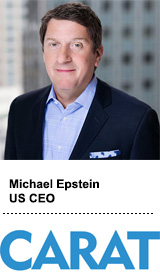
Media agencies, especially those owned by big holding companies, have always relied on economies of scale to get the best pricing for clients.
While scale is still important in a digital world, agencies are finding strategy is a better value proposition for brands trying to make sense of data and technology and apply it to their marketing efforts, said Carat US CEO Michael Epstein.
“We’ve leaned more toward scale than strategy, and I think that’s shifting back,” he said. “I don’t want to work at a media agency, nor do I want Carat to be an agency, that’s just about buying cheap media.”
To bring tech and data strategy into its offer, Carat now pitches more with its sister agencies under the Dentsu Aegis Network (DAN), including creative agency McGarryBowen, database marketing agency Merkle and programmatic hub Amnet. Carat was part of the DAN’s recent successful pitch for Intel and will service the brand’s B2C efforts while iProspect and Merkle work on B2B.
“How we’re working together as a network has been a fairly compelling story,” Epstein said. “Clients want to pick the best of the best, either from the network or the industry. So, I think we’ll do more of it.”
He spoke with AdExchanger.
AdExchanger: Scale has always been the big value prop for media agencies. Is that changing?
MICHAEL EPSTEIN: Yes and no. Cost and pricing are always a component. Where the value prop is starting to change is clients are looking at their data and saying, “How do I make better sense of this and get greater impact out of it?”
We’re working on our three-year plan, which includes how we think about data and tech advisory and how to move from predicting media outcomes to performance and sales outcomes.
How are you approaching new ways of buying TV?
Clients are open to anything that will [help] them mitigate what’s going on in the TV marketplace. I don’t decry TV or think it’s going to be dead any time soon. In many cases, we’ve seen clients shift spend back to TV because it does work, particularly in driving volume. But they want to mitigate what seems like an impeded inflation.
It’s not going to be easy to switch the way we transact. I firmly believe, as do most of our clients, that more things need to be addressable. We’re moving to more personalized experiences. We’re rethinking reach on a personalized level. We’re thinking through an addressable video marketplace using [Merkle’s] M1 platform. I don’t think we’re there yet.
How is Carat using M1? Do your clients use it?
Clients are using it to some extent. Our planning tools sit on top of it, so clients don’t have to tap into the data or activate through the publisher addressable marketplace (PAM). They can run other syndicated data. But insights and planning are all done on M1.
Mapping survey data to behavioral data paints a very different picture of the consumer. It’s sending us into different channels. The real benefit is getting insights to create better plans that lead to better activations. If you can get better insights from the beginning, performance will follow.
Are clients using PAM?
Some are. It has been one of the more complex things to work through in my career. We struggled with how we were telling the story. There’s the occasional concern about cost and transparency, although it’s fully transparent. It’s just legacy in our business. When you have conversations about activating data, it naturally leads to that.
What services do your clients need most from you today?
Budgets are under pressure, so they’re asking us to prove performance. Fraud and brand safety have become things that every client is rightfully demanding we control. Google and Facebook are hiring tens of thousands of people to combat bots and fraud, so they’re asking us about that.
They’re asking us to help them make better sense of the data they have. And they’re asking us to be committed to them, which should not be forgotten.
Are clients still cutting spend? How are you managing that?
Some clients’ businesses are performing quite well, and their scrutiny is probably too aggressive on investment versus other brands that might not have as much growth. CPG is more disrupted than a technology company, which has powered some of that disruption.
Are any of your clients bringing your services in-house?
It hasn’t really impacted us. One client took programmatic in-house and another is about to. With data privacy laws, that’s an awful big risk for a company.
I think the younger workforce likes diversity of thought. Taking it in-house, you might not get the best talent and retain it. If we’re struggling with it as a media agency, I don’t know how hard it is for a client.
We still spend more money in TV than anything else. That will be hard for clients to take in-house. My opinion is if clients try it, ultimately it comes back.
How does Carat attract the right talent in a competitive market?
Our most important asset is our people. We’re focused on training leadership. We’re committed to increasing the digital acumen of the agency. We also do let people work from home one day a week or flex their hours. You need to give people the liberty to think and be themselves.
But it’s not easy. Media is an exciting industry, but they have a wide variety of opportunities from TV networks to digital platforms. So, we try to keep them engaged.
This interview has been edited and condensed.
This post was syndicated from Ad Exchanger.


More Stories
Around the World: AI & Christmas, a Temu crackdown and Aussie influencers
Here’s a Short Roundup for This Week
Melanie Spencer a finalist in Campaign’s Agency of the Year Awards